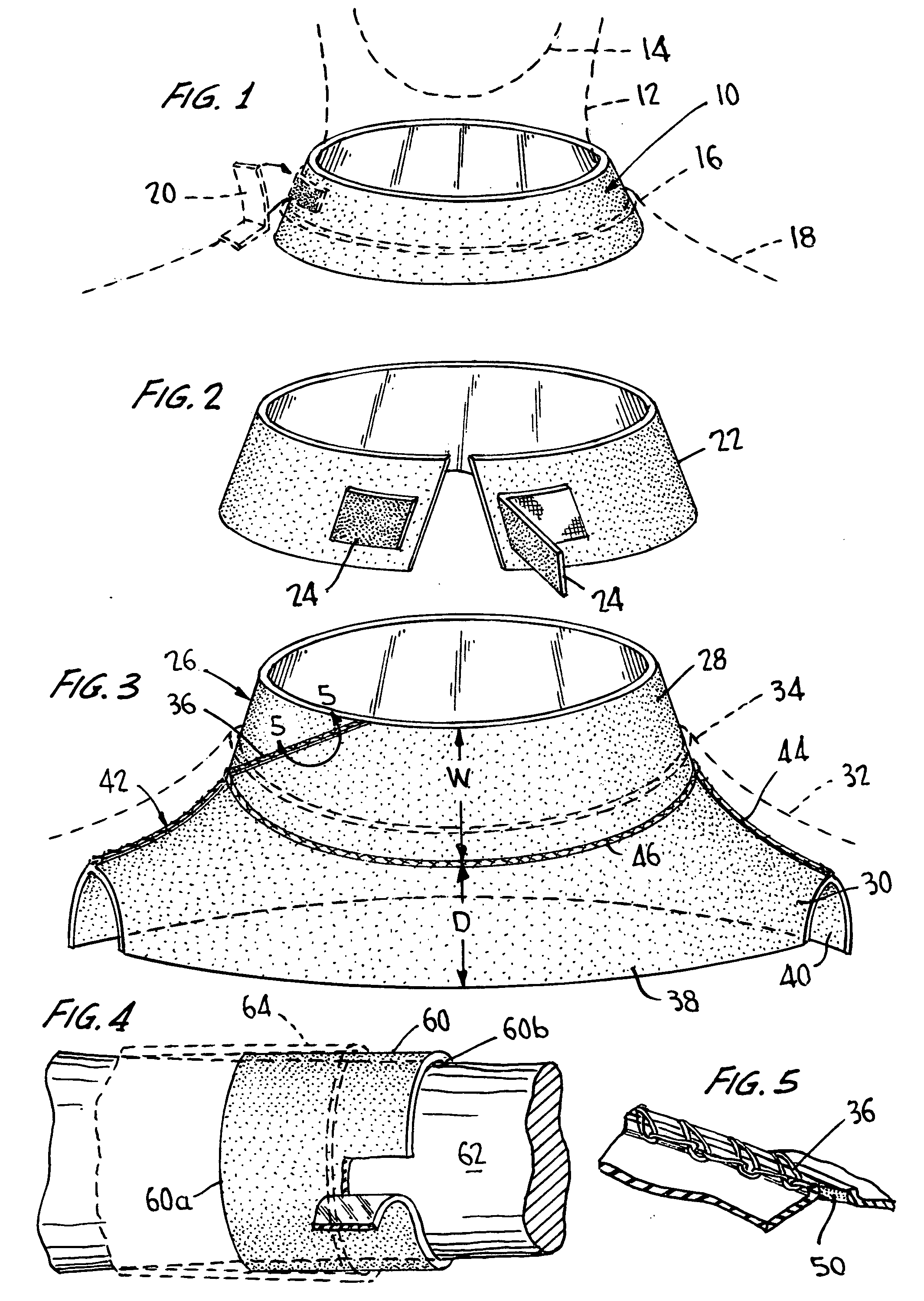Wetsuit neck and arm protective members
a protective member and neck technology, applied in the field of protective members, can solve the problems of not being able to prevent chafing, the neck protection member tends to not be retained where desired, etc., and achieve the effect of reducing water incursion
- Summary
- Abstract
- Description
- Claims
- Application Information
AI Technical Summary
Benefits of technology
Problems solved by technology
Method used
Image
Examples
first embodiment
[0021]As mentioned above, FIG. 1 shows the neck-protective member of the invention. In this embodiment, the neck-protective member 10 is a continuous band of neoprene, which may comprise the “smoothskin” neoprene rubber material, with the smooth surface disposed to the inside. Typically member 10 will be formed by cutting a strip of suitable material and sewing and gluing its ends together, preferably using the seam detail discussed below in connection with FIG. 5. In this embodiment, the member is stretched so as to be pulled over the head and neck 14 of the wearer and is sized to fit snugly around the wearer's neck 12. Typically, the band of neoprene will be 2-6 inches wide and of a circumference to fit the neck of the wearer snugly. It may comprise a generally conical shape, as shown, so as to fit over the wearer's neck, or may be shaped so as to extend downwardly, e.g. partially over the wearer's back, shoulders, and chest. Internally it should have a smooth surface so there is ...
second embodiment
[0023]FIG. 2 shows the neck-protective member of the invention, wherein the member 22 is provided as a discontinuous neoprene strip, typically 2-6 inches wide and 10-22 inches long, to suit the neck of the wearer. Cooperating hook-and-loop fasteners 24 are used to attach one end of the strip to the other. In order not to disrupt the smoothness of the internal part of the collar, the hook-and-loop fasteners 24 should be provided as small patches approximately 2½ inches wide and 3 inches long, and should be mounted about ½ inch away from the ends of the guard. Again, the member 22 is worn under the wetsuit, wrapped around the neck so that the edge of the neck aperture in the wetsuit lies on the member 22, preventing neck chafing. Again, the member 22 can be shaped so as to fit principally around only the wearer's neck, or may be shaped so as to extend downwardly, e.g. partially over the wearer's back, shoulders, and chest. As in the case of the FIG. 1 embodiment, further cooperating h...
third embodiment
[0024]FIG. 3 shows the neck-protective member 26 of the invention, which is currently preferred. In this embodiment, the neck-protective member 26 comprises a continuous neck-surrounding band portion 28, sized to fit snugly, so that it must be stretched so as to be pulled over the head of the wearer, both as in the FIG. 1 embodiment, but also comprises a skirt portion 30 attached to the bottom of the neck-surrounding band portion 28. The skirt portion extends well underneath the shoulder portion of the wetsuit 32, partially covering the back, shoulders, and chest of the wearer, so that the neck-surrounding band portion 28 protrudes from the neck aperture 34 in the wetsuit 32, preventing chafe of the wearer's neck against the edge of the neck aperture 34 in the wetsuit 32.
[0025]More particularly, and as indicated above, in this preferred embodiment the neck-protective member of the invention 26 comprises a generally conical neck-surrounding band portion 28, which fits around the wear...
PUM
 Login to View More
Login to View More Abstract
Description
Claims
Application Information
 Login to View More
Login to View More - R&D
- Intellectual Property
- Life Sciences
- Materials
- Tech Scout
- Unparalleled Data Quality
- Higher Quality Content
- 60% Fewer Hallucinations
Browse by: Latest US Patents, China's latest patents, Technical Efficacy Thesaurus, Application Domain, Technology Topic, Popular Technical Reports.
© 2025 PatSnap. All rights reserved.Legal|Privacy policy|Modern Slavery Act Transparency Statement|Sitemap|About US| Contact US: help@patsnap.com


